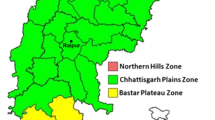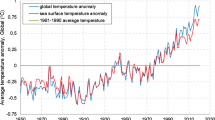Abstract
In this study, a deep learning algorithm namely long short-term memory (LSTM) has been developed for forecasting daily pan evaporation at Sydney airport, Australia. The accuracy of the developed LSTM model has been compared with a commonly used machine learning model, namely multilayer perceptron neural network (MLP-NN). The evaporation rate as a single parameter was used with one time-lag based on autocorrelation function (ACF). The utilized data duration was from January 2021 to February 2022 (during Covid-19 pandemic). Different statistical measurements have been applied in order to evaluate the performance of the proposed models. The results showed that the developed LSTM model outperformed MLP-NN. The LSTM performed well with RMSE = 1.074, MAE = 0.771, R2 = 0.97, while the MLP-NN had least performance with RMSE = 2.801, MAE = 1.994, and R2 = 0.57. The developed LSTM model could be utilized in other locations for forecasting daily pan evaporation.









Similar content being viewed by others
Data Availability
Not applicable.
Code Availability
Not applicable.
Abbreviations
- LSTM:
-
Long short-term memory
- MLP-NN:
-
Multilayer perceptron neural network
- ACF:
-
Autocorrelation function
- RMSE:
-
Root mean square error
- MAE:
-
Mean absolute error
- R 2 :
-
Coefficient of determination
- ANN:
-
Artificial neural network
- MLP:
-
Multilayer perceptron
- RBF:
-
Radial basis function
- ANFIS:
-
Adaptive neuro-fuzzy interface system
- ANFIS-SA:
-
Adaptive neuro-fuzzy interface system-shark algorithm
- SVR:
-
Support vector regression
- CART:
-
Classification and regression tree
- CCNNs:
-
Cascade correlation neural networks
- GEP:
-
Gene expression programming
- ELR:
-
ElasticNet linear regression
References
Abed, M., Imteaz, M. A., Ahmed, A. N., & Huang, Y. F. (2021). Application of long short-term memory neural network technique for predicting monthly pan evaporation. Scientific Reports, 11, 1–19. https://doi.org/10.1038/s41598-021-99999-y.
Allawi, M. F., Othman, F. B., Afan, H. A., et al. (2019). Reservoir evaporation prediction modeling based on artificial intelligence methods. Water (Switzerland). https://doi.org/10.3390/w11061226.
Allawi, M. F., Aidan, I. A., & El-Shafie, A. (2021). Enhancing the performance of data-driven models for monthly reservoir evaporation prediction. Environmental Science and Pollution Research, 28, 8281–8295. https://doi.org/10.1007/s11356-020-11062-x
Bowyer, D., & Chapman, R. L. (2014). Does privatisation drive innovation? Business model innovation through stakeholder viewpoints: The case of Sydney Airport 10 years post-privatisation. Journal of Management & Organization, 20, 365–386. https://doi.org/10.1017/jmo.2014.16
Ehteram, M., Yenn, F., Najah, A., et al. (2020). Performance improvement for infiltration rate prediction using hybridized adaptive neuro-fuzzy Inferences System (ANFIS) with optimization algorithms. Ain Shams Engineering Journal, 11, 12. https://doi.org/10.1016/j.asej.2020.08.019
El Bilali, A., Abdeslam, T., Ayoub, N., et al. (2023). An interpretable machine learning approach based on DNN, SVR, Extra Tree, and XGBoost models for predicting daily pan evaporation. Journal of Environmental Management, 327, 116890. https://doi.org/10.1016/j.jenvman.2022.116890
Freestone, R., & Tice, A. (2013). Airports as Development Generators: A reconnaissance of employment trends in the Sydney airport region 1996–2011.
Ghorbani, M. A., Kazempour, R., Chau, K. W., et al. (2018). Forecasting pan evaporation with an integrated artificial neural network quantum-behaved particle swarm optimization model: A case study in Talesh, Northern Iran. Engineering Applications of Computational Fluid Mechanics, 12, 724–737. https://doi.org/10.1080/19942060.2018.1517052
Hochreiter, S., & Schmidhuber, J. (1997). Long short-term memory. Neural Computation. https://doi.org/10.1162/neco.1997.9.8.1735.
IPCC (2018). Global warming of 1.5°C.
Jumin, E., Basaruddin, F. B., Yusoff, Y. B. M., et al. (2021). Solar radiation prediction using boosted decision tree regression model: A case study in Malaysia. Environmental Science and Pollution Research. https://doi.org/10.1007/s11356-021-12435-6
Kisi, O., Genc, O., Dinc, S., & Zounemat-Kermani, M. (2016). Daily pan evaporation modeling using chi-squared automatic interaction detector, neural networks, classification and regression tree. Computers and Electronics in Agriculture, 122, 112–117. https://doi.org/10.1016/j.compag.2016.01.026
Lai, V., Malek, M. A., Abdullah, S., et al. (2020). Time-series prediction of sea level change in the east coast of Peninsular Malaysia from the supervised learning approach. Int J Des Nat Ecodynamics. https://doi.org/10.18280/ijdne.150314.
Latif, S. D. (2021). Concrete compressive strength prediction modeling utilizing deep learning long short-term memory algorithm for a sustainable environment. Environmental Science and Pollution Research. https://doi.org/10.1007/s11356-021-12877-y
Latif, S. D., Birima, A. H., Najah, A., et al. (2021). Development of prediction model for phosphate in reservoir water system based machine learning algorithms. Ain Shams Engineering Journal. https://doi.org/10.1016/j.asej.2021.06.009
Majhi, B., Naidu, D., Mishra, A. P., & Satapathy, S. C. (2020). Improved prediction of daily pan evaporation using Deep-LSTM model. Neural Computing And Applications, 32, 7823–7838. https://doi.org/10.1007/s00521-019-04127-7.
Mohamadi, S., Ehteram, M., & El-Shafie, A. (2020). Accuracy enhancement for monthly evaporation predicting model utilizing evolutionary machine learning methods. International Journal Of Environmental Science And Technology, 17, 3373–3396. https://doi.org/10.1007/s13762-019-02619-6.
Parsaie, A., Haghiabi, A. H., & Latif, S. D. (2021). Predictive modelling of piezometric head and seepage discharge in earth dam using soft computational models. Environmental Science And Pollution Research. https://doi.org/10.1007/s11356-021-15029-4.
Perkins, K. M., Munguia, N., Ellenbecker, M., et al. (2021). COVID-19 pandemic lessons to facilitate future engagement in the global climate crisis. Journal Of Cleaner Production, 290, 125178. https://doi.org/10.1016/j.jclepro.2020.125178.
Shabani, S., Samadianfard, S., & Sattari, M. T. (2020). Modeling pan evaporation using gaussian process regression K-Nearest neighbors Random Forest and support vector machines; comparative analysis. Atmosphere (Basel). https://doi.org/10.3390/ATMOS11010066
Shiri, J. (2018). Evaluation of a neuro-fuzzy technique in estimating pan evaporation values in low-altitude locations. Meteorological Applications. https://doi.org/10.1002/met.1753.
UN (2019). The sustainable development goals report.
Yaseen, Z. M., Al-Juboori, A. M., Beyaztas, U., et al. (2020). Prediction of evaporation in arid and semi-arid regions: A comparative study using different machine learning models. Engineering Applications of Computational Fluid Mechanics. https://doi.org/10.1080/19942060.2019.1680576
Acknowledgements
The author would like to thank Australian Government for providing data through the Bureau of Meteorology.
Funding
Not applicable.
Author information
Authors and Affiliations
Corresponding author
Ethics declarations
Conflict of interest
The author declares no conflict of interest.
Ethics approval
Not applicable.
Consent to participate
Not applicable.
Consent for publication
Not applicable.
Additional information
Publisher’s Note
Springer Nature remains neutral with regard to jurisdictional claims in published maps and institutional affiliations.
Rights and permissions
Springer Nature or its licensor (e.g. a society or other partner) holds exclusive rights to this article under a publishing agreement with the author(s) or other rightsholder(s); author self-archiving of the accepted manuscript version of this article is solely governed by the terms of such publishing agreement and applicable law.
About this article
Cite this article
Latif, S.D. Evaluating deep learning and machine learning algorithms for forecasting daily pan evaporation during COVID-19 pandemic. Environ Dev Sustain 26, 11729–11742 (2024). https://doi.org/10.1007/s10668-023-03469-6
Received:
Accepted:
Published:
Issue Date:
DOI: https://doi.org/10.1007/s10668-023-03469-6




